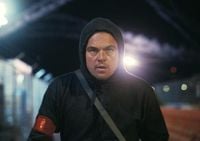Paul Thomas Anderson’s latest cinematic venture, One Battle After Another, has arrived in theaters with a bang—literally and figuratively. Adapted from Thomas Pynchon’s 1990 novel Vineland, the film is a sprawling, genre-bending drama that stretches across 16 tumultuous years of American history, from the Nixon era through the late 1980s Drug Wars. At its core, the movie is a wild, sometimes zany caper about revolutionaries, family, and the harsh realities of U.S. immigration policy, all wrapped in Anderson’s signature blend of comedy and political commentary.
Starring Leonardo DiCaprio as Pat—later known as Bob Ferguson—the story kicks off with Pat and his partner Perfidia, played by Teyana Taylor, as members of the French 75, a band of revolutionaries whose motives center around fighting America’s ever-hardened stance on immigration. According to ICSFilm, “Their objectives are a bit hazy, but coalesce around America’s immigration policies. These are harsh no matter what administration runs the show, and have been for decades.” Perfidia’s volatile nature and Pat’s expertise with explosives make them a formidable pair, but their personal lives are just as chaotic as their political ambitions.
The film’s plot takes a sharp turn when a bank heist goes wrong and Perfidia is arrested. In exchange for a spot in the witness protection program, she betrays her comrades, leaving Pat to raise their daughter, Willa (Chase Infiniti), alone and under a new identity in the backwoods near Baktan Cross. Sixteen years later, Pat—now Bob—struggles with substance abuse and the challenges of fatherhood, while Willa navigates the ordinary trials of teenage life. But peace is short-lived. When news arrives that a former French 75 member has been caught, the villainous Col. Steven J. Lockjaw (Sean Penn) closes in, threatening to upend their fragile existence.
Anderson’s adaptation doesn’t shy away from the darker corners of American history. In one of the film’s most powerful moments, armed border patrol guards march past cages filled with Hispanic children—a chilling echo of real-world events that, as ICSFilm notes, “suddenly flashes of Donald Trump’s first presidency loom over the film like bad nightmares.” Yet, the movie’s satirical ambitions sometimes undercut its emotional and political bite. The review argues, “For satire to truly have bite, the thing that it satirizes needs a certain degree of specificity.” Instead, the film’s humor often leans toward the cartoonish, with Penn’s Lockjaw and Tony Goldwyn’s Virgil Throckmorton portrayed as almost comically sinister figures. The critique continues: “The cartoonish nature... hides the evilness and decidedly less funny side of white supremacy. These guys are a laughing matter; Stephen Miller is not.”
Despite its comedic tone, One Battle After Another grapples with weighty themes—racism, white supremacy, and the cyclical nature of American repression. Yet, the emotional heartbeat of the film, the bond between Bob and Willa, is criticized for never quite landing. “The connection between father and daughter never develops because Anderson separates them after one scene and doesn’t reunite them until the very end,” writes ICSFilm. The supporting cast, including Benicio del Toro as Willa’s karate sensei and Regina Hall in a more grounded role, are largely consigned to outsized or underused characters. Taylor’s Perfidia, perhaps the film’s most psychologically complex figure, exits the narrative far too soon.
Still, there’s no denying the film’s entertainment value. Clocking in at a hefty 162 minutes—just twenty minutes shy of three hours—the movie moves at a brisk pace, thanks in large part to Jonny Greenwood’s percussive, metronomic score. The action is relentless, with the middle act devolving into one chase scene after another, culminating in a show-stopping car chase through the hilly deserts of Southern California. This sequence, reminiscent of Steven Spielberg’s Duel, is a standout, building tension without dialogue, relying instead on revving engines and Greenwood’s nervous piano chords.
Yet, for all its technical prowess and star power, One Battle After Another faces an uphill battle at the box office. According to MovieWeb, the film grossed $3.1 million in preview screenings and is projected to earn around $22.4 million in the U.S. and $48.5 million worldwide—a respectable showing for a Paul Thomas Anderson film, but modest given its blockbuster $140 million production budget. For comparison, Anderson’s previous film, Licorice Pizza, earned only $350,000 in its opening weekend, and his most commercially successful film, There Will Be Blood, topped out at $77 million globally.
Why the muted response? As MovieWeb suggests, Anderson’s name doesn’t carry the same mainstream weight as directors like Christopher Nolan or franchises like Marvel. “It’s because not that many people know who Paul Thomas Anderson is. Anderson isn’t a household name, much less a box office draw, beyond a certain sphere of cinephiles,” the article notes. The film’s complex tone—neither clearly arthouse nor straightforward action—may have left general audiences unsure of what to expect, despite DiCaprio’s star power and the film’s high-octane marketing campaign.
The film’s marketing struggled to bridge this gap. The first trailer, released in March 2025, highlighted DiCaprio’s desperate search for his daughter and the resistance’s secret codes, while the second, more traditional trailer muddied the waters further. As MovieWeb puts it, “While the first trailer seemed to advertise a fun arthouse film, the second one seemed to advertise a serious action movie. Arthouse movies don’t make much money, and action movies struggle to when they don’t star the likes of Iron Man or John Wick.”
Despite these hurdles, the film has received glowing reviews and an impressive A Cinemascore, suggesting that those who do see it are largely won over. The hope is that positive word-of-mouth will help One Battle After Another find a broader audience in the weeks ahead—especially as awards season heats up and Warner Bros. Pictures campaigns the film alongside its other prestige contenders.
Ultimately, One Battle After Another is a film that refuses to fit neatly into any one box. It’s a blockbuster with brains, a comedy with teeth (albeit not always sharp ones), and a political drama that, for all its missed opportunities, remains “damn entertaining.” For Anderson, it’s a bold swing—one that may not conquer the box office, but will undoubtedly linger in the minds of those who give it a chance.

